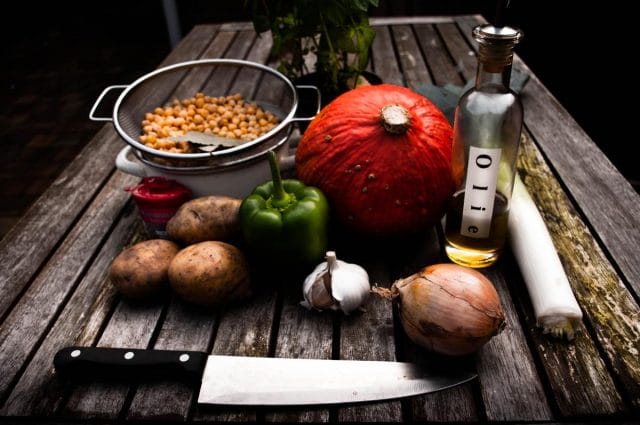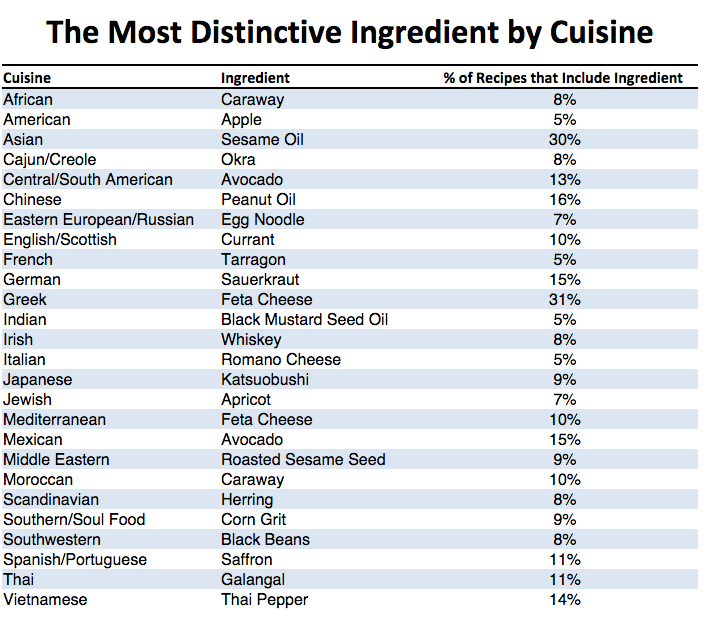
Defining a national or cultural cuisine is tricky business. For virtually any cuisine, there are food critics who will claim that the cuisine is too diverse to pin down (for example, see these articles on Mexican, Indian, Chinese cuisines). In his attempt to define American cuisine, food writer Bill Daley was reminded of Supreme Court justice Potter Stewart’s famous stance on pornography, “I know it when I see it.”
But just because it’s difficult to define, doesn’t mean we can’t try. The popular recipe website Epicurious tags each of its recipes with a “cuisine” label. We looked at which ingredients were statistically over-represented in recipes from particular cuisines. We wanted to understand exactly which ingredients separate “American” or “Indian” dishes from the ones tagged as “Chinese” and “Jewish.” We also discovered which meats, in particular, are favored by which cuisines.
***
To understand a culture’s cuisine, is in part, to understand the ingredients that are most typically used. Ingredients are often associated with a cuisine as a result of geographical circumstance (fish in Japan), cultural history (ham’s central role in Spanish cuisine) or both.
In order to determine which ingredients distinguish the cuisines of the world, we used a publicly available dataset. The dataset consisted of the ingredients for over 13,000 recipes posted on Epicurious by late 2013, and the recipe’s cuisine tag. The data set includes both savory and sweet dishes from 26 different cuisines (42 cuisine choices are now available, but there were only 26 when the data was collected), and no drinks. Because many of the recipes on Epicurious come from American publications like Gourmet and Bon Appetit, the findings do however represent a US-centric view of world cuisines.
What Ingredients Are Most Common in the Cuisines of World?
We begin our examination of the ingredients that characterize cuisines by each cuisine’s most common ingredient. The following table lists the 26 cuisines in our dataset, along with that cuisine’s most common, and the percentage of recipes it can be found in. For example, the most common ingredient in Southwestern dishes is cayenne, which is in 81% of all recipes in our dataset (no other cuisine has an ingredient more frequently used). Salt and sugar are not included in the data set because they are so common across recipes.

Dan Kopf, Priceonomics; Data: Epicurious
For the majority of cuisines, the most common ingredient is a cooking lubricant like butter or oil. Northern and southern European cuisines display a clear divide on butter and olive. Butter for the Germans, English/Scottish and Scandinavians, and Olive Oil for the Spanish/Portuguese and Greek.
In most other cuisines, the most common ingredient is a condiment or a seasoning: soy sauce, fish sauce, garlic, onion. The one exception to the trends is Jewish cuisine, in which eggs are the most common ingredient. This is perhaps due to the unique place of eggs in Jewish dietary restrictions.
What Ingredients Are Most Distinctive in the Cuisines of the World?
We next look at which ingredients are used at an unusually high rate in different cuisines. In the table below, the most distinctive ingredient is defined as the ingredient that is most likely to be in that cuisine, relative to recipes from the rest of the world. (We also required that the ingredient was present in at least 5% of recipes within the cuisine.)
For example, peanut oil is the most distinctive ingredient of Chinese cuisine, because it is found in 16% of Chinese recipes, but less than 2% of the non-Chinese recipes. Thus it is eight times more frequently used in Chinese dishes than it is in other cuisines.

Dan Kopf, Priceonomics; Data: Epicurious
Thai food is distinguished by the use of galangal, also called siamese ginger, and it just might be why you like those curries so much. Galangal is found in over 10% of Thai dishes, but in only 0.1% of the dishes of other cuisines.
It seems you can’t compare apples to oranges, or any other food for that matter, in their exceptional role in American cuisine. Apples are nearly 3 times more likely to be found in American recipes than non-American ones. Johnny Appleseed can rest in peace.
The Meat-o-Meter: Which Meats Are in Different Types of Recipes?
There is incredible variety in the different meats emphasized in different cuisines. Take bacon for example. While it is a staple of German, Irish and American Southern cuisines, its use is almost entirely omitted from many others, including Thai, Greek and Jewish cuisines. The use of most other meats is similarly diverse.
We conclude our analysis with the “Meat-o-Meter” interactive below. The interactive allows you to explore 8 different types of meat and the percentage of dishes that include this meat in each cuisine in our dataset. For example, we learned by choosing chicken from the drop down that chicken is a very limited part of Irish cuisine. While other types of meat are not divided by how they are prepared, pork, perhaps the most charismatic of meats, is divided into its three primary incarnations: ham, bacon, and ‘pork.’
![]()
This post was written by Dan Kopf; follow him on Twitter here. To get occasional notifications when we write blog posts, please sign up for our email list.



